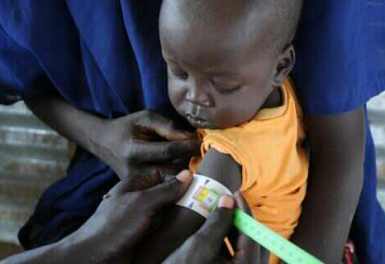Acute malnutrition in S. Sudan beyond emergency threshold: report
September 11, 2019 (JUBA) – More than half the population of South Sudan do not know where their next meal will come from, in spite of a slight improvement in the food security situation since June 2019, three United Nations agencies warned in report issued Wednesday.

The report estimates that 10 000 people are currently in Catastrophe (IPC Phase 5) and facing an extreme lack of food, while about 1.7 million are in Emergency (IPC Phase 4) and another 4.6 million people are experiencing Crisis (IPC Phase 3) levels of acute food insecurity.
While the Greater Upper Nile region continues to be the most food insecure, followed by the Greater Bahr el Ghazal region, those in Catastrophe are in Yirol East of the former Lakes state and will need urgent humanitarian support to save their lives.
Although the food security situation is severe, the recent improvement can largely be attributed to the Revitalized Peace Agreement (R-ARCSS), signed in September 2018. The decrease in armed conflict has encouraged the voluntary return of farmers, increasing access to livelihoods and improving markets. A more stable political environment has also allowed for improved delivery of humanitarian assistance to the most vulnerable populations.
“With political stability and sustained peace, South Sudan could quickly recover from the crisis and boost its food production. The IPC findings are still alarming, but they also show that the revitalized peace agreement is bearing dividends and its full implementation is of utmost significance for the country,” said Meshack Malo, FAO Representative in South Sudan.
“FAO is working with returning farmers to assist them resettle, build their livelihoods and produce their own food,” he added.
Acute malnutrition levels among children under five years of age have increased significantly, from 13 percent in 2018 to 16 percent in 2019 – which is above the emergency threshold of 15 percent.
It is estimated that 1.3 million children will be affected by acute malnutrition in 2020.
“The increase in acute malnutrition among children in South Sudan tells us how complex malnutrition is but also how much longer it takes to rebuild a country, compared to shattering it,” said Mohamed Ag Ayoya, UNICEF Representative in South Sudan.
“This situation calls for a paradigm shift, putting prevention first, before scaling up treatment. This shift includes promotion of age appropriate complementary feeding for children, prevention of malaria and diarrhoea, access to clean water, proper hygiene, and health care. Only then can children truly thrive,” he added.
The food security situation in South Sudan is expected to improve from now and towards the end of the year, as seasonal harvests become available. However, the UN agencies estimate that 4.5 million people will still face Crisis, Emergency or Catastrophe levels of food insecurity and will need assistance.
“The latest report goes to show that if you give peace a chance, you are likely to make food security a reality,” said Matthew Hollingworth, WFP’s Country Director in South Sudan.
“Now is not the time to rest on our laurels as millions of people are still struggling to survive in the country. Rather, we need to re-double our efforts and maintain the gains that peace has enabled,” he added.
Meanwhile, UNICEF and 40 civil society organizations are reportedly providing key nutrition interventions for children and women in South Sudan. UNICEF said it is supporting 1,150 outpatient therapeutic programme centres and 99 stabilization centres across South Sudan.
(ST)
